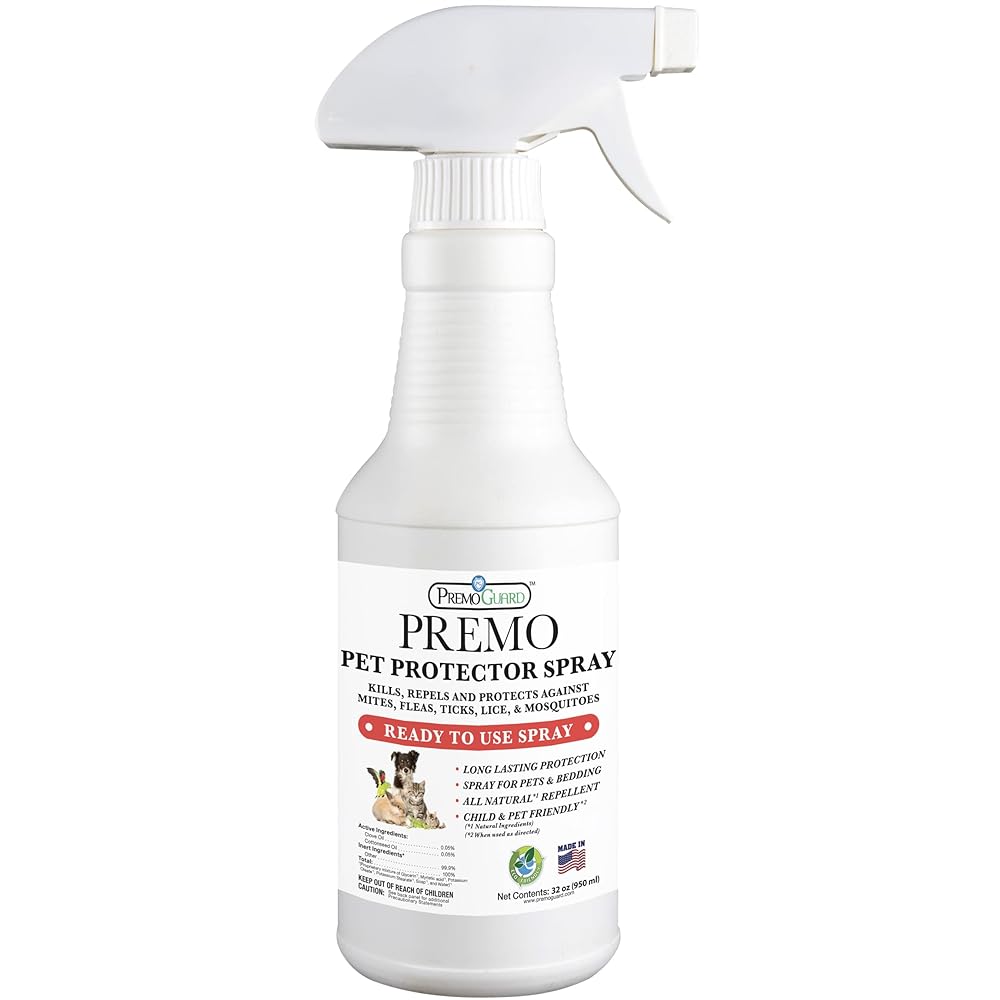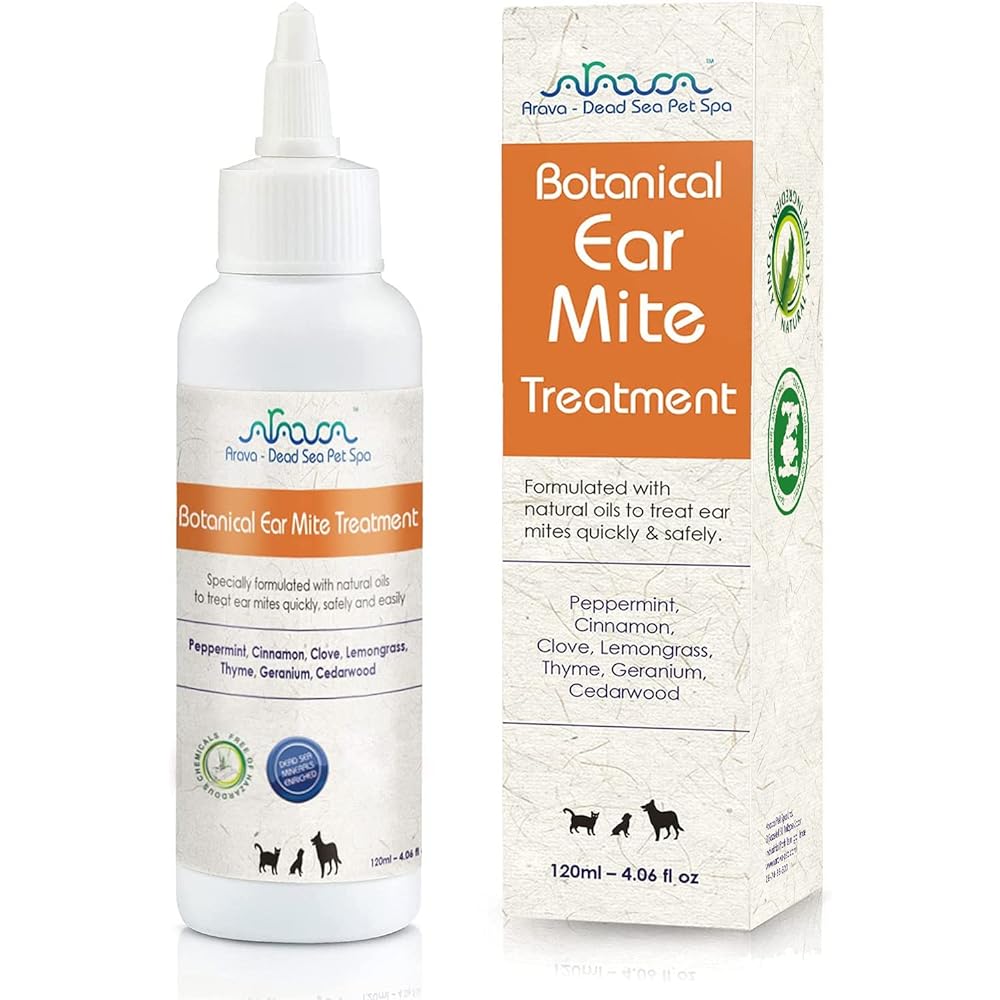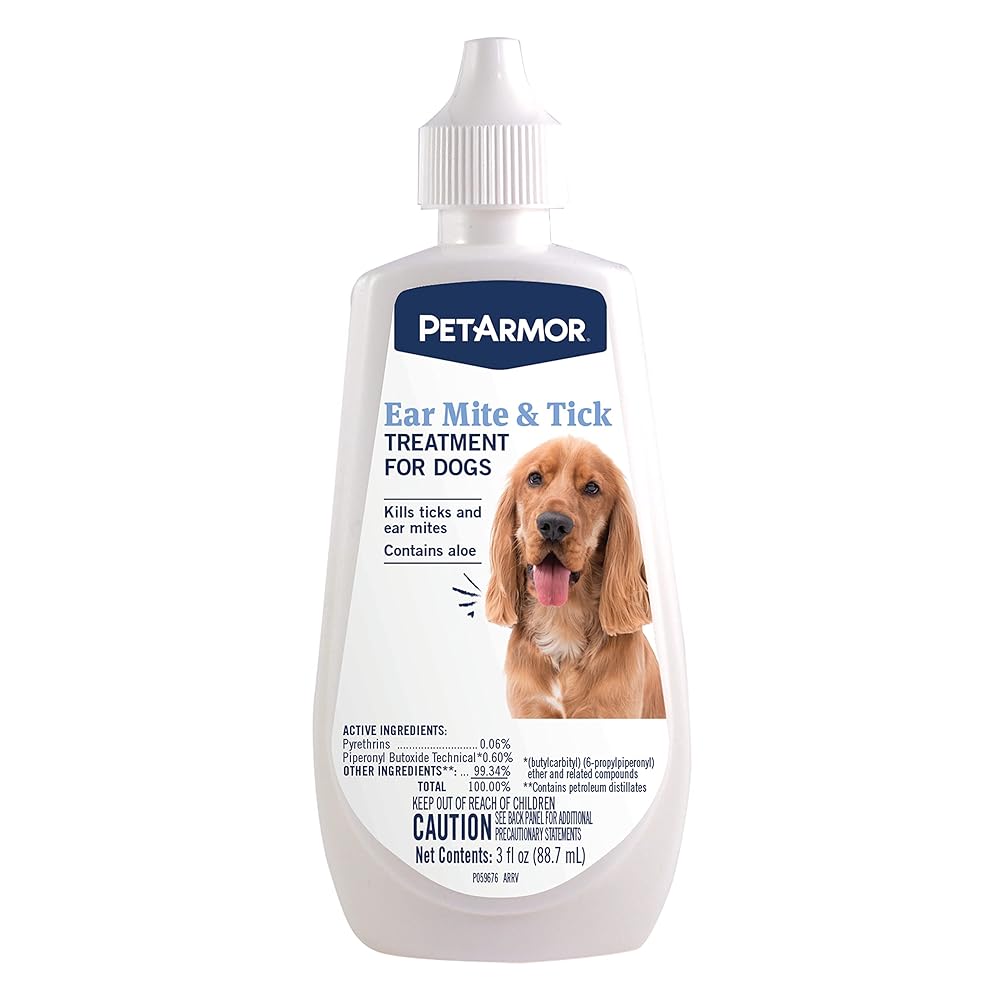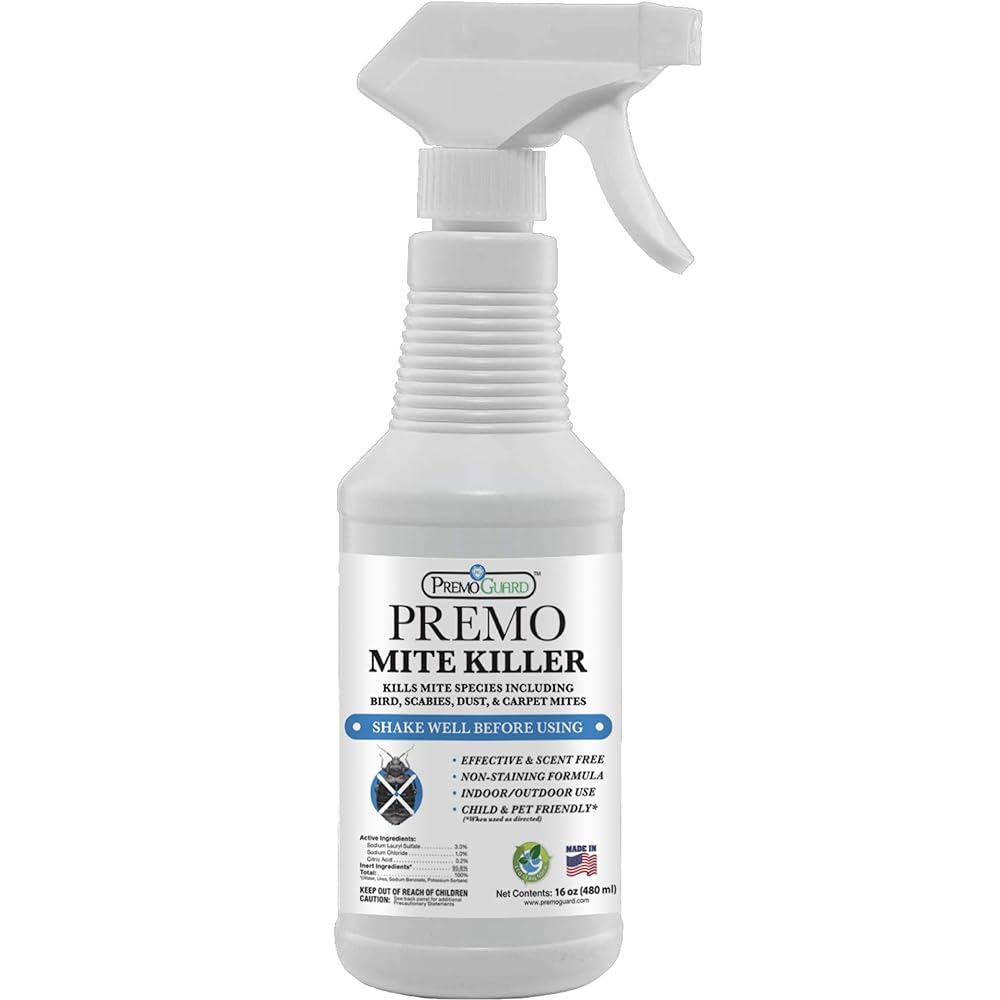iHeartDogs is reader-supported. Some of the links below may be paid affiliate links, where we receive a small commission on a product at no additional cost to you.
Mites, tiny creatures often invisible to the naked eye, can wreak havoc on a dog’s skin and overall well-being. From causing uncomfortable itching to transmitting diseases, these microscopic pests are more than just an annoyance. With the myriad of treatments and preventive measures available, dog owners often find themselves overwhelmed by choices. This article delves into the best mite prevention and treatments for dogs, ensuring that your furry friend remains itch-free and in top health.
#1 – Pet Protector by Premo Guard – 100% Effective Mite, Flea, Tick, & Mosquito Spray for Dogs, Cats, and Pets – Best Natural Protection for Control, Prevention, & Treatment – 32 oz
The Pet Protector by Premo Guard is a natural and non-toxic spray that effectively repels and treats mites, fleas, ticks, and mosquitoes on dogs, cats, and other pets. It is made from natural essential oils and is veterinarian approved for direct application on all pets. The spray is safe for all pets, including puppies and kittens, and can be used throughout the home. Additionally, the product is stain-free and made in the U.S.A.

#2 – Arava Natural Ear Mite Treatment – for Dogs & Cats – Pet Ear Mites Infection Cleaner – Treat Inaccessible Areas & Prevent Infections – NOT for Cats Under 13 LBS & Puppies Under 9 Months
The Arava Natural Ear Mite Treatment is a solution for treating ear mite infections in dogs and cats. It contains natural ingredients and Dead Sea minerals to effectively eliminate mites and keep your pet’s ears clean. It is important to note that this treatment is not suitable for cats under 13 lbs and puppies under 9 months. Results can be seen in just 10 days, and it can be combined with Arava Pet Ear Wipes for maximum effectiveness. The product also offers a 30-day money-back guarantee.

#3 – PetArmor Ear Mite and Tick Treatment for Dogs, 3 oz
The PetArmor Ear Mite and Tick Treatment for Dogs is a 3 oz bottle designed to effectively kill ticks and ear mites, providing relief from itching. The treatment contains aloe, which may provide additional soothing benefits. It offers a convenient solution for dog owners looking to address tick and ear mite issues without the need for vet visits or costly medications.

#4 – Mite Killer Spray by Premo Guard 16 oz – Treatment for Dust Spider Bird Rat Mouse Carpet and Scabies Mites – Fast Acting 100% Effective – Child & Pet Safe – Best Natural Extended Protection
The Mite Killer Spray by Premo Guard is a safe and natural solution for treating mites. Made from natural organic ingredients, it is suitable for use in homes, farms, yards, and during travel. It is proven to be effective in killing a variety of mite species and is stain and scent-free. The product is tested for quality and is supplied from certified facilities.

#5 – Adams Ear Mite Treatment For Dogs and Cats Over 12 Weeks, Kills Ear Mites On Contact, Relief For Dogs and Cats Suffering From Ear Mites, Soothing Aloe and Lanolin Formula .5 Fl Oz
Adams Ear Mite Treatment is a product designed to kill ear mites in dogs and cats over 12 weeks of age. It contains aloe and lanolin to help soothe irritated skin. The treatment should be used daily for 7-10 days and can be repeated after two weeks if necessary. The easy-to-use applicator tube makes it convenient for pet owners to apply the treatment. Adams is a trusted brand that has been providing protection against fleas, ticks, and mosquitoes since 1975. They also offer customer support through their website.

How Can I Tell If My Dog is Infected by Mites?
Detecting a mite infestation in your dog can sometimes be challenging due to the microscopic size of many mites. However, there are several symptoms and signs you can look out for:
- Intense Itching and Scratching: One of the most common signs of a mite infestation is a dog that can’t stop scratching. Mites irritate the skin, leading to incessant itching.
- Redness and Inflammation: Areas infested by mites may appear red and inflamed, especially if your dog has been scratching or biting at the area.
- Hair Loss: Mites can lead to hair loss in affected areas, often in patches. This is especially common with the Demodex mite.
- Dandruff or Scaly Skin: Some mites, like the Cheyletiella mite, can cause flaky skin or what looks like dandruff.
- Ear Mites: If your dog has ear mites, you might notice excessive head shaking, a foul odor from the ears, or a dark, coffee-ground-like discharge within the ear canal.
- Bumps or Lesions: In some cases, mites can cause the development of small bumps or lesions on the skin.
- Secondary Infections: The damage caused by mites and the dog’s scratching can lead to bacterial or fungal infections, exacerbating the symptoms.
If you suspect your dog may be suffering from a mite infestation, it’s essential to consult with your veterinarian. They can conduct a skin scraping test or other diagnostics to confirm the presence of mites and recommend an appropriate course of treatment.
What Are The Dangers of Mites for Dogs?
Mites pose several challenges and dangers to dogs, ranging from mild irritations to severe health complications. Here’s a breakdown of some of the concerns related to mite infestations in dogs:
- Skin Irritations and Inflammations: At the fundamental level, mites can cause intense itching and discomfort for dogs. The incessant scratching and biting in response can lead to skin inflammations, commonly known as dermatitis.
- Secondary Bacterial and Fungal Infections: Open sores and wounds from scratching provide an entry point for bacteria and fungi. This can lead to secondary infections that may require additional treatments beyond just addressing the mites.
- Transmission of Diseases: Certain mites, like the Sarcoptes scabiei mite responsible for scabies (sarcoptic mange), can transmit diseases.
- Hair Loss: Chronic mite infestations can lead to hair loss, which might be temporary or, in severe cases, permanent.
- Immune System Compromise: Some mites, particularly the Demodex mite, flourish when a dog’s immune system is compromised. While Demodex mites are naturally present on dogs in small amounts, an overgrowth can indicate an underlying health issue.
- Ear Infections: Ear mites, if left untreated, can lead to severe ear infections. These infections can become chronic and may even affect the dog’s hearing if not addressed.
- Spread to Other Animals or Humans: While many mites are host-specific, some, like the mites causing scabies, can be transmitted to other pets or even humans, causing similar irritations.
- Chronic Health Conditions: If not treated promptly, mite infestations can lead to long-term health challenges, such as chronic skin disorders.
- Stress and Behavioral Changes: The constant discomfort and itching can cause a significant amount of stress in dogs. This stress might manifest as behavioral changes, reduced appetite, or even aggression in some cases.
- Systemic Illness: In rare cases, especially if a secondary bacterial infection enters the bloodstream, it can lead to septicemia, a life-threatening condition.
It’s crucial for dog owners to recognize the signs of mite infestations early on and seek veterinary advice promptly. Early detection and treatment can prevent many of the more severe complications associated with mites.
Frequently Asked Questions About Mite Prevention and Treatment Products for Dogs
- What are the common signs that my dog might have a mite infestation?
- Common indications of mite infestations in dogs include intense itching, redness and inflammation of the skin, hair loss, and sometimes the presence of tiny bumps or blisters. If mites are in the ears, you might also notice head shaking, scratching at the ears, and a waxy discharge.
- Are there natural remedies for treating mites on dogs?
- Yes, some natural remedies such as aloe vera, neem oil, and apple cider vinegar are believed to be effective against mites. However, it’s essential to consult a vet before trying any home remedies to ensure they’re safe and suitable for your specific situation.
- How often should I apply mite prevention products to my dog?
- The frequency of application varies depending on the product. Some treatments are monthly, while others might be more or less frequent. Always read the label and follow the manufacturer’s guidelines, and consult with your vet if unsure.
- Can mite treatments for dogs be harmful to humans or other pets?
- Some mite treatments can be toxic if ingested or if they come into contact with the skin, so it’s crucial to handle them with care. Always keep them out of reach of children and other pets and wash your hands thoroughly after application.
- Is it necessary to treat my home if my dog has mites?
- In some cases, especially with mites like the Sarcoptes scabiei (scabies), it’s a good idea to treat your home. Mites can linger in bedding, carpets, and furniture, so cleaning these areas can help prevent reinfestation.
- Do mite preventatives also protect against other parasites?
- Many mite preventatives also protect against other common parasites like fleas and ticks. However, it’s essential to read the product label or consult your vet to ensure it covers the specific parasites you’re concerned about.
- Are puppies more susceptible to mites?
- Puppies can be more vulnerable to certain mites, such as the Demodex mite, due to their immature immune systems. It’s essential to monitor puppies closely for signs of mite infestations and consult a vet if any symptoms arise.
- Can I bathe my dog after applying mite treatment?
- Bathing your dog right after applying a topical mite treatment can reduce its effectiveness. It’s generally recommended to wait at least 48 hours after treatment before bathing your dog. Again, consult the product’s label or your vet for guidance.
- Are there oral medications available for mite prevention and treatment?
- Yes, several oral medications are effective against mites and other parasites. They’re often preferred by dog owners who don’t like topical treatments. As always, consult your vet for recommendations suitable for your dog.
- Can I combine different mite treatments and preventatives?
- Combining treatments without vet guidance can be risky, as it might lead to overmedication or adverse reactions. Always consult your veterinarian before using multiple products or if considering switching to a different treatment.
Conclusion: Best Mite Prevention & Treatments for Dogs
Ensuring the health and comfort of our dogs is a responsibility all pet owners hold dear. In the battle against mites, armed with knowledge and the right products, you can help your dog avoid these pesky invaders or recover more swiftly if they’re affected. Remember, while treatments are essential when an infestation occurs, prevention remains the best approach. Regular check-ups with your veterinarian and staying vigilant about your dog’s environment are crucial steps in maintaining a mite-free, happy, and healthy canine companion.
 Toledo, United States.
Toledo, United States.
